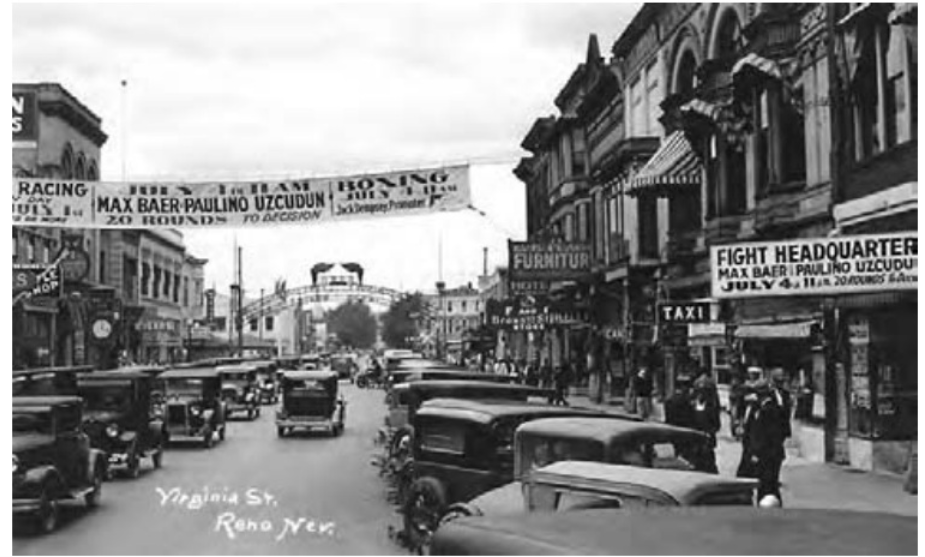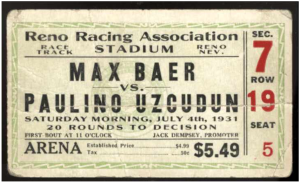Featured Articles
When Boxing Was Big on the Fourth of July: A TSS Classic

We’re going way back, but there was a time when the Fourth of July was a big day for boxing in the U.S. The high-water mark, according to BoxRec, was set in 1922 when there were 67 shows spread across 27 states. In that year, the holiday fell on a Tuesday.
Two of the most historically significant fights were staged on the Fourth of July. In 1910, in a fight that “marinated” for almost five years, Jack Johnson successfully defended his world heavyweight title at the expense of former champion James J. Jeffries. Measured by the amount of newsprint expended on this story as it developed, Johnson vs. Jeffries was the biggest single-day sporting event in the history of man. In 1919, Jack Dempsey dethroned Johnson’s conqueror Jess Willard, the first big bang in the Golden Era of Sports. And although it didn’t move the needle, how appropriate in hindsight that Joe Louis began his pro career on the Fourth of July.
During the early years of the 20th century, promoters often hitched their events to other events – county fairs, carnivals, race meets, national conventions of fraternal organizations, and so forth. One might call these festival fights. The 1931 show in Reno featuring Max Baer and Paulino Uzcudun was an example. It was, in many ways, the quintessential Fourth of July boxing show, a window into western Americana.
In 1931, Reno (the “Biggest Little City in the World”) was home to about 20,000 people. Twice that number swarmed into Reno on that year’s Fourth of July. “Special trains by the score, automobiles by the hundreds and airplanes by the dozen poured into the famous divorce metropolis from the Pacific Coast. From the sandy wastes of Nevada came prospectors on burros, cowboys on horseback and ranchers in buckboard wagons,” said the correspondent for the United Press.
The race meet was in progress and there were sundry other activities arranged to make the day special, but the big shebang was the prizefight.
The spearheads of the promotion, Bill Graham and James McKay, owned the Bank Club, Reno’s biggest casino. Business was booming now that Nevada had legalized gambling, not that it made much difference in Reno where gambling was wide-open before the new law took effect.
Graham and McKay had made their fortunes running gambling saloons in Nevada mining towns and could afford to commit big dollars to the promotion. They brought in the great ring announcer Dan Tobey from Los Angeles (520 miles away) to serve as the master of ceremonies — Tobey was the Michael Buffer of his day — but their big coup was getting Jack Dempsey involved. Dempsey was retired, having last fought in 1927, but the Manassa Mauler was still a towering personality and his involvement ensured good national newspaper coverage. For advertising purposes, he was named the actual promoter, the makeshift wooden stadium erected in the infield of the thoroughbred track was named for him, and he would serve as the bout’s referee.
At this stage of their respective careers, Max Baer and Paulino Uzcudun were borderline journeymen. Baer’s best days were ahead of him, but he had lost three of his last five. Uzcudun had lost four of his last seven beginning with a 15-round setback to Max Schmeling at Yankee Stadium. But Baer was still recognized as a man with a pulverizing punch and the pairing was smart from a geographical perspective. Baer had cultivated a strong following in northern California, Reno’s primary tourist market. Uzcudun, who had his early fights in Paris, hailed from the Basque region of Spain.
The Reno area was home to many people of Basque descent, and Uzcudun, nicknamed the Basque Woodchopper, had a ready-made fan base. It was 11 pm on June 4 when Uzcudun arrived in Reno on the Southern Pacific to set up his training quarters, but despite the late hour, thousands were reportedly at the rail terminal waiting to greet him.
Baer arrived a few days later. It was customary in those days for the headliners in a big show outside a major metropolis to arrive in the host city several weeks before the event. They held public workouts and were squired around town to press the flesh to goose the gate.
With the city about to be inundated by a great throng, the Chamber of Commerce undertook a campaign to discourage price-gouging. The District Attorney cautioned homeowners renting beds to visitors to exercise caution when accepting checks, “particularly checks drawn on banks in other cities.” Those that came by rail and could afford a berth in a Pullman car brought their own hotel rooms. The Pullmans were diverted to a side track where they sat until the excursionists were ready to leave.
There was never a dull moment in Reno, a place where gambling houses operated around the clock. Reporters had plenty to write about besides the big fight. The cantankerous mayor, E.E. Roberts, was quite a character. To boost tourism, he “advocated placing a barrel of corn whiskey on every corner of the city with a dipper attached and a sign directing all favorably inclined to drink as much as they pleased.” Prohibition was still in effect and this didn’t sit well with federal prohibition agents. On June 30, the day prior to the start of the racing meet and four days before the big fight, agents from the San Francisco office descended on the city, raiding 19 saloons and arresting 37 people for violating the Volstead Act. By most accounts, this barely dented the city’s saloon industry.
The Fight

Although no title was at stake, the bout — billed as the “Battle of the Sagebrush” — was scheduled for 20 rounds. It was a messy affair fought on a sweltering day where the temperature at ringside climbed into the mid-90s. “On occasion they butted like goats,” said a ringside reporter.
The match, which lasted the full distance, struck some reporters as vicious and others as rather tame – there were no knockdowns — but on two matters everyone agreed: it was a closely contested contest and both Baer and Uzcudun exhibited great stamina. By and large, Baer landed the cleaner punches but Uzcudun, who had a famously awkward style, a peek-a-boo defense grafted to a low crouch, stubbornly pressed the action and was commended for his tenacity.
At the end of the 19th round, referee Dempsey, the sole arbiter, leaned over to a group of reporters and told them that he would award the fight to the man that had the best of it in the final round. That proved to be the Basque Woodchopper, who had attracted most of the bets in the betting shed built adjacent to the arena.
The attendance was listed at 18,000, but it would be reported that only 9,260 paid. Looking back 10 years later, an attendee recalled that “gatecrashers by the hundreds swarmed over the racetrack fences and infiltrated from all angles. There just weren’t enough cops, ushers, and guards to handle them.”
The promoters reportedly lost money, but the visitors must have been good spenders because Dempsey was back in Reno with another Fourth of July prizefight the following year. The 1932 promotion, pitting Max Baer against King Levinsky in the main event, was a big disappointment, playing out in a half-empty stadium, but at least those in attendance could say that they got to see a future heavyweight champion in action. Not quite two years later, Baer massacred Primo Carnera at an outdoor arena in Queens, igniting a short- lived title reign. (Rising heavyweight contender Joe Louis would subsequently defeat all three of the Reno headliners, knocking out Levinsky, Baer, and Uzcudun, in that order, in consecutive bouts.)
Reno’s second “Battle of the Sagebrush” was a would-be extravaganza that fell flat, the fate of most holiday festival fights, a development that the late, great sportswriter John Lardner attributed to “chuckleheaded boosterism.”
That’s a story for another day. In the meantime, here’s wishing everyone a Happy Fourth of July.
EDITOR’S NOTE: This is a reprint of a story that ran on these pages on July 2, 2018.
To comment on this story in the Fight Forum CLICK HERE
Arne K. Lang’s latest book, titled “George Dixon, Terry McGovern and the Culture of Boxing in America, 1890-1910,” will shortly roll off the press. The book, published by McFarland, can be pre-ordered directly from the publisher (https://mcfarlandbooks.com/product/clashof-the-little-giants) or via Amazon.
-

 Featured Articles4 weeks ago
Featured Articles4 weeks agoAvila Perspective, Chap. 330: Matchroom in New York plus the Latest on Canelo-Crawford
-

 Featured Articles3 weeks ago
Featured Articles3 weeks agoVito Mielnicki Jr Whitewashes Kamil Gardzielik Before the Home Folks in Newark
-

 Featured Articles1 day ago
Featured Articles1 day agoResults and Recaps from New York Where Taylor Edged Serrano Once Again
-

 Featured Articles4 weeks ago
Featured Articles4 weeks agoCatching Up with Clay Moyle Who Talks About His Massive Collection of Boxing Books
-

 Featured Articles6 days ago
Featured Articles6 days agoFrom a Sympathetic Figure to a Pariah: The Travails of Julio Cesar Chavez Jr
-

 Featured Articles1 week ago
Featured Articles1 week agoCatterall vs Eubank Ends Prematurely; Catterall Wins a Technical Decision
-

 Featured Articles3 weeks ago
Featured Articles3 weeks agoMore Medals for Hawaii’s Patricio Family at the USA Boxing Summer Festival
-

 Featured Articles4 weeks ago
Featured Articles4 weeks agoRichardson Hitchins Batters and Stops George Kambosos at Madison Square Garden





















